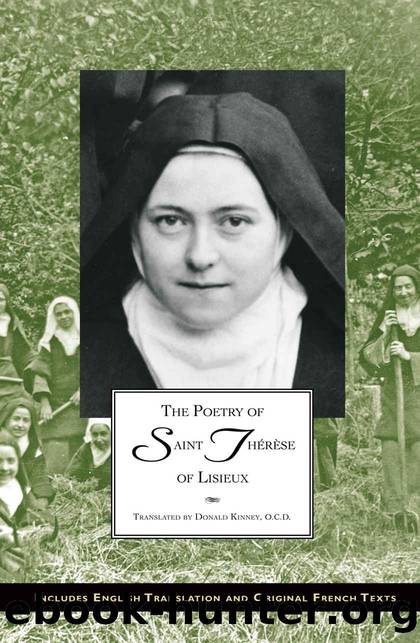The Poetry of Saint Therese of Lisieux by St. Therese of Lisieux

Author:St. Therese of Lisieux [St. Therese of Lisieux]
Language: eng
Format: epub
Publisher: ICS Publications
Published: 2013-09-16T16:00:00+00:00
* * *
1 “The flower is the smile of God,” she wrote at Christmas of 1894 (RP 2).
PN 35 – To Our Lady of Victories
(July 16, 1896)
[In the original French] this is rhymed prose rather than true poetry. However, it represents an important aspect of Thérèse's vocation: her apostolic goal. This page is a step toward the opening out of her vision to the entire universe, which unfolds in Manuscript B of Story of a Soul.
Receiving her first spiritual brother (Maurice Bellière) in October 1895 struck “musical strings” for the very first time in Thérèse's soul (SS, p. 251). She felt nothing like that when she accepted a second spiritual brother (Adolphe Roulland) in May 1896. Naturally she was delighted, but she was also hesitant (SS, p. 253), yet the repercussions were just as deep.
In 1895 Thérèse expressed her feelings in an intimate prayer for the first seminarian she had “adopted.”1 In 1896, she wrote this spontaneous, personal poem to render her “song of love and gratitude” for Fr. Roulland. In it her apostolic zeal becomes more passionate. Better still than the previous year, she sings of victory: “Now my desire will come true” (Pri 8), and this would take place “through him” (Fr. Roulland), two words she repeats insistently.2
Thérèse's spiritual companionship with Abbé Bellière took longer to mature. With Fr. Roulland, everything took place very quickly, in one burst. Entrusted to our Carmelite on May 30, 1896, this young priest of the Foreign Missions of Paris celebrated a first Mass at the Carmel of Lisieux on July 3. He spoke with his Sister in the parlor and talked of his future mission in Eastern Szechuan.3 He left her a book to help her locate their mission field. Thérèse soon had herself photographed with this book beside her. For that photo, she held in her hand a scroll of paper with this thought by St. Teresa of Avila: “I would give a thousand lives to save just one soul!…” (GCII, pp. 974–975). Fr. Roulland set sail for China on August 2. In the meantime, his sister copied about ten of her best poems for him. She ended the collection with the canticle “To Our Lady of Victories.” Before he set sail, Fr. Roulland had “already read and reread it” (GCII, p. 981). He added, “I would like to be able to respond to it, but God wills me to be prosaic: I do enjoy, however, the beauties of poetry that comes from the heart” (ibid.).
These events powerfully reactivated the missionary flame in Thérèse. Her relationship with Fr. Roulland brought a temporary relief to her great desires for apostolic fruitfulness. “Through him” she will be an “apostle”—and “what hope!”—”a martyr”—and better yet, through that “communion of saints” that was being revealed more and more to her.
All this added fuel to the fire. Soon Thérèse's desires were causing her “a veritable martyrdom” (SS, p. 193). The poem “To Our Lady of Victories” (whose title was given careful consideration)4 and the incandescent letter
Download
This site does not store any files on its server. We only index and link to content provided by other sites. Please contact the content providers to delete copyright contents if any and email us, we'll remove relevant links or contents immediately.
The Hating Game by Sally Thorne(17460)
The Universe of Us by Lang Leav(14358)
Sad Girls by Lang Leav(13344)
The Lover by Duras Marguerite(7110)
Smoke & Mirrors by Michael Faudet(5506)
The Rosie Project by Graeme Simsion(5183)
The Shadow Of The Wind by Carlos Ruiz Zafón(4932)
Big Little Lies by Liane Moriarty(4876)
The Poppy War by R. F. Kuang(4415)
Memories by Lang Leav(4166)
What Alice Forgot by Liane Moriarty(3914)
An Echo of Things to Come by James Islington(3833)
From Sand and Ash by Amy Harmon(3674)
The Poetry of Pablo Neruda by Pablo Neruda(3358)
The Tattooist of Auschwitz by Heather Morris(3245)
Guild Hunters Novels 1-4 by Nalini Singh(2929)
Ficciones by Jorge Luis Borges(2854)
THE ONE YOU CANNOT HAVE by Shenoy Preeti(2822)
The Rosie Effect by Graeme Simsion(2704)
